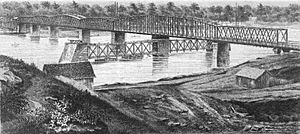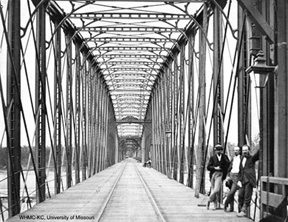Octave Chanute facts for kids
Quick facts for kids
Octave Chanute
|
|
|---|---|
 |
|
| Born | 18 February 1832 |
| Died | 23 November 1910 (aged 78) |
| Resting place | Springdale Cemetery, Peoria, Illinois |
| Citizenship | French, American |
| Occupation | Civil engineer, railway engineer and bridge designer, aviation pioneer |
Octave Chanute (born February 18, 1832 – died November 23, 1910) was a French-American civil engineer and a very important person in the early days of aviation. He helped many people who were trying to build flying machines, including the famous Wright brothers. He also shared their flying experiments with the public. When he died, many called him the "father of aviation" because of his big ideas about how flying machines could work.
Contents
Octave Chanute's Life Story
Octave Chanute was born in Paris, France. His father, Joseph Chanut, was a professor. In 1838, when Octave was six years old, he moved with his father to the United States. His father became a Vice-President at Jefferson College in Louisiana. Octave went to private schools in New York.
A Career in Civil Engineering
Octave Chanute started learning about civil engineering in 1848. Civil engineers design and build things like bridges, roads, and buildings.
He was known as a very smart and creative engineer. During his career, he designed and built two of the largest stockyards in the United States: the Chicago Stock Yards (in 1865) and the Kansas City Stockyards (in 1871).
He also designed and built the Hannibal Bridge in Kansas City, Missouri. This was a very important bridge because it was the first one to cross the Missouri River in that city in 1869. This bridge helped Kansas City become a major city in the region. Chanute designed many other bridges for railroads, including ones over the Illinois River, the Genesee River Gorge, and the Mississippi River. He also designed the Kinzua Bridge in Pennsylvania.
Protecting Wood for Railroads
Chanute also found a way to make wooden railroad ties last longer. Railroad ties are the pieces of wood that hold the tracks in place. He used a special treatment to protect the wood from decay. He built the first factories to do this and convinced railroad companies that spending money on treating the wood would save them money in the long run by reducing replacement costs. He also introduced "date nails" in the U.S. These small nails were hammered into railroad ties to show when they were installed, helping to track how long they lasted.
Chanute stopped working for the Erie Railway in 1883. After that, he became an independent engineering consultant, meaning he worked for himself and advised different companies.
A Pioneer in Aviation
Chanute became interested in flying after seeing a balloon go up in 1856. When he retired from his railroad career in 1883, he decided to spend his free time helping the new science of aviation.
He used his engineering skills to gather all the information he could find about flight experiments from around the world. He wrote about his findings in a series of articles from 1891 to 1893. These articles were later published in a very important book called Progress in Flying Machines in 1894. This book was the most complete survey of heavier-than-air flying research at that time.
In 1893, Chanute helped organize a successful conference about flying at the World's Columbian Exposition in Chicago.
Chanute was too old to fly himself, so he worked with younger experimenters like Augustus M. Herring and William Avery. In 1896, they tested gliders (aircraft without engines) in the sand dunes near Miller Beach, Indiana. They tried designs based on the work of German pioneer Otto Lilienthal, as well as their own ideas.
These experiments showed Chanute that the best way to get more lift without making the aircraft too heavy was to stack several wings on top of each other. This idea led to the "biplane" design, which has two main wings. Chanute introduced the "strut-wire" design, which used struts (supports) and wires to make the wings strong. This design was used in many early powered biplanes. The Wright brothers used Chanute's "double-decker" design for their gliders.

Chanute wrote letters to many other aviation pioneers around the world. In 1900, he started writing to the Wright brothers after they read his book. Chanute helped tell the world about the Wright brothers' work and always encouraged them. He even visited their camp in Kitty Hawk, North Carolina, several times between 1901 and 1903. The Wrights and Chanute exchanged hundreds of letters.
Chanute believed in sharing knowledge about aviation freely with everyone. He thought others should do the same, though he did encourage people to get patents for their inventions. This open approach caused some disagreements with the Wright brothers. They believed their ideas about how to control aircraft were special and did not want to share them.
Chanute did not think the Wrights' patent, which was based on "wing warping" (twisting the wings to steer), could be fully enforced. He said this publicly. He admired the Wrights' achievements but felt they were spending too much time on lawsuits instead of focusing on their work. Even though their friendship was strained, Wilbur Wright attended Chanute's memorial service.
In 1910, Chanute became the first president of the Aero Club of Illinois.
Death
Octave Chanute passed away on November 23, 1910, in Chicago.
How Octave Chanute is Remembered
Many things are named after Octave Chanute to honor his contributions:
- The town of Chanute, Kansas, is named after him.
- The former Chanute Air Force Base in Illinois was also named for him. It used to have the Octave Chanute Aerospace Museum, which told the story of aviation.
- Since 1902, the Western Society of Engineers has given out the Octave Chanute Award for important engineering ideas.
- From 1939 to 2005, the American Institute of Aeronautics and Astronautics gave the Chanute Flight Award to pilots or test personnel who made great contributions to aviation.
- In 1963, Chanute was added to the National Aviation Hall of Fame in Ohio.
- In 1974, he was inducted into the International Air & Space Hall of Fame.
- In 1978, the U.S. Postal Service released special 21-cent airmail stamps honoring Octave Chanute.
- In 1996, the National Soaring Museum recognized the 100th anniversary of his glider experiments as a National Landmark of Soaring.
- Embry-Riddle Aeronautical University in Florida has a student residence hall called the Chanute Complex.
- The Gary Bathing Beach Aquatorium in Gary, Indiana, has a museum dedicated to Octave Chanute and the Tuskegee Airmen.
- He is also shown in the Frieze of American History in the Capitol Rotunda in Washington D.C., alongside other aviation pioneers.
Timeline

See also
 In Spanish: Octave Chanute para niños
In Spanish: Octave Chanute para niños
- Octave Chanute Award
- The "Pioneer Era" (1900–1914) of Aviation history






